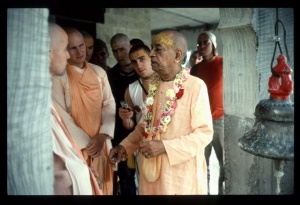CC Madhya 18.101 (1975)

A.C. Bhaktivedanta Swami Prabhupada
Below is the 1996 edition text, ready to be substituted with the 1975 one using the compile form.
TEXT 101
- kṛṣṇa kene daraśana dibe kali-kāle?
- nija-bhrame mūrkha-loka kare kolāhale
SYNONYMS
kṛṣṇa—Lord Kṛṣṇa; kene—why; daraśana—interview; dibe—would give; kali-kāle—in this Age of Kali; nija-bhrame—by their own mistake; mūrkha-loka—foolish persons; kare kolāhale—make a chaotic tumult.
TRANSLATION
“Why would Kṛṣṇa appear in the Age of Kali? Foolish people who are mistaken are simply causing agitation and making a tumult.
PURPORT
Śrī Caitanya Mahāprabhu’s first statement (kṛṣṇa kene daraśana dibe kali-kāle) refers to the scriptures. According to scripture, Kṛṣṇa appears in Dvāpara-yuga, but He never appears as Himself in Kali-yuga. Rather, He appears in Kali-yuga in a covered form. As stated in Śrīmad-Bhāgavatam (SB 11.5.32), kṛṣṇa-varṇaṁ tviṣākṛṣṇaṁ sāṅgopāṅgāstra-pārṣadam. Kṛṣṇa appears in the Age of Kali in the garb of a devotee, Śrī Caitanya Mahāprabhu, who always associates with His internal soldiers—Śrī Advaita Prabhu, Śrī Nityānanda Prabhu, Śrīvāsa Prabhu and Gadādhara Prabhu. Although Balabhadra Bhaṭṭācārya was personally serving Lord Kṛṣṇa in His role as a devotee (Caitanya Mahāprabhu), he mistook Lord Kṛṣṇa for an ordinary man and an ordinary man for Lord Kṛṣṇa because he did not follow the rules set down by śāstra and guru.